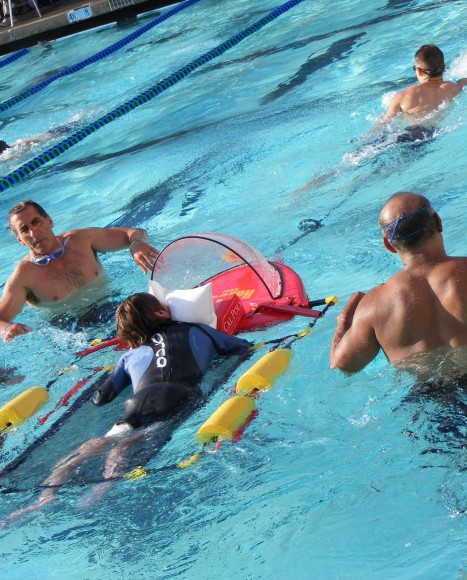Cal Poly students have invented a device that allows disabled 20-year old college student Joseph Cornelius to glide along the water, providing the sensation of swimming.
With no muscle control over his limbs due to cerebral palsy, Joseph still loves to exercise and has competed in 100 foot races with the help of his father, John Cornelius, under the team name “Team Joseph.”
Until now, he has been unable to swim because of the danger of water getting into his lungs. “Aquabullet,” the Cal Poly invention, is a hydrodynamic watercraft created by Cal Poly students Paul Sands, Lilly Hoff and Andrea Voigt for their senior project, and has been designed to reduce the risk of water entering Joseph’s lungs through use of a clear plastic splashguard.
Aside from the splashguard, Aquabullet is made up of a support system consisting of floats and mesh. The bow and headrest are both made out of Precision Board Plus donated by Coastal Enterprises.
The students designed and built Aquabullet after extensive research and testing in collaboration with Joseph and his father. Funding was provided by a National Science Foundation grant to Cal Poly, along with the support of donated materials from several vendors.
Aquabullet design mock-up:
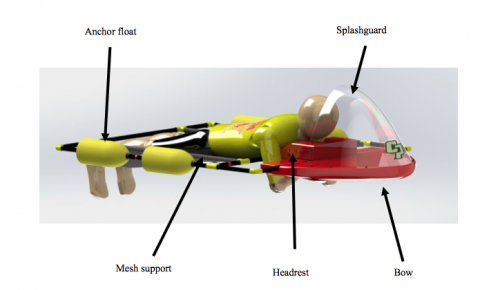
According to Cal Poly student Paul Sands, “Michael Lara, Manager at the Special Olympics of Southern California, pitched the idea [for a senior project] to the entire class of Mechanical Engineering seniors at Cal Poly, and both Lilly [Hoff] and myself picked it as our number one choice. For years, the Mechanical Engineering and Kinesiology departments have collaborated on different projects. For this reason, Andrea Voigt, a Kinesiology major, was brought onboard with her considerable experience in swimming and working with people with disabilities.”
Finding the most ergonomically-comfortable device was challenging. “After testing 6 or 7 different crude mockups, searching for a design with the most comfortable position for Joseph, we decided on one that would allow him to lay on his stomach,” says Sands.
“Construction of Aquabullet was started by sanding and shaping a piece of 6 lb. Precision Board we cut from a larger block, followed by painting it with red acrylic paint and applying fiberglass,” recalls Sands.
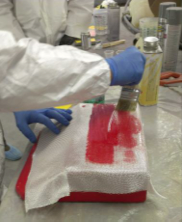
After the fiberglass was cured and the rough edges filed down, a hard coat was painted over it consisting of a mixture of surfacing agent and laminating resin. Extensive sanding, followed by a 3-stage polishing process ensured that the headrest would be comfortable for Joseph to rest on.
The bow was made out of 8 lb Precision Board in the same process as the headrest, painting it with red acrylic paint prior to fiberglassing and sealing it.

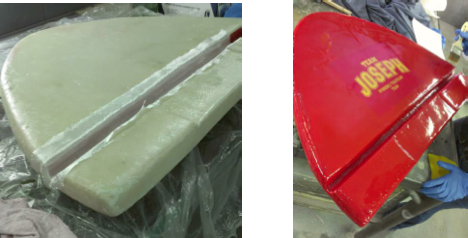
After both pieces were finished, students fabricated the splashguard with the assistance of local motorcycle windshield manufacturer Rifle through an extrusion blow molding process.
Each piece was assembled together, completing the Aquabullet:
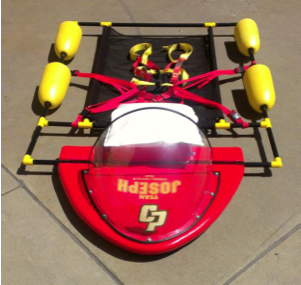
Aquabullets successful completion allowed Joseph Cornelius to successfully swim in the San Luis Obispo Triathlon, of which additional information can be seen at: Pictures of the event and additional information here.
At the completion of Aquabullet, the students had noted several proposed production and vehicle changes for the future, and Paul Sands plans to make improvements to Aquabullet, and also design another vehicle before he graduates this December. Long term goals include patenting the design and potentially producing it, as this form of an “Adaptive Sport Vehicle” has the potential to provide a therapeutic activity to many people with disabilities.
Paul can be reached at: psands22@gmail.com or (909) 583-5643.
Parties interested in additional information about Team Joseph can contact John Cornelius at: jcorn224@yahoo.com.
